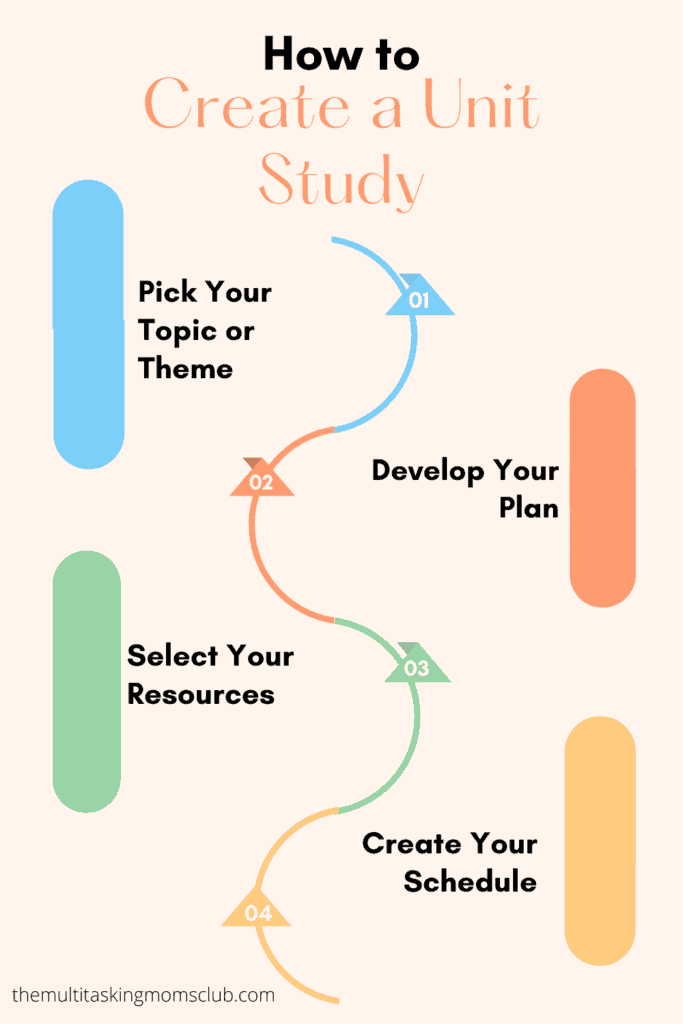It is actually easy and fun to create a unit study! If you are homeschooling and wondering what all the hoopla is around unit studies, well, here is your guide!
Unit studies are designed to take your children through their traditional subjects (English, History, Science, and Math) based on a single topic or theme. This allows your child to follow their interests, while still hitting on each subject. Using a single topic across subjects also helps your child dig deeper and allows for continuity across all their school work.
Another great advantage of unit studies is that a larger family can do one unit study together across grades. The older children will dig deeper into the theme or topic, but they will all be learning together!
So, how do you create a unit study yourself? It’s not as daunting a challenge as you may think!

Pick a Topic or Theme
The first step is to pick your theme or topic. This, of course, is where your child’s (or children’s) interests come into play. THEY should decide (or have a say in) the topic they want to study.
Really, the sky is the limit here. Topics can range from a country (China, for example), an historical era (the Renaissance perhaps), a favorite animal (dogs or dinosaurs), skills (such a cooking or coding), a weather phenomenon (tornados or tsunamis), landforms (mountains or deserts). You get the picture.
Sit down with your child (or children) and have a fun brainstorming session. Keep in mind that some topics may be too broad, thus would need to be narrowed down. My daughter once wanted to do a unit study on Art. Um, Okay. Where to start? That is simply too broad a subject, so we narrowed it down to drawing. Honestly, even that was a bit overwhelming. But, art was her passion, so I went with it!
Develop Your Plan
Once you have your topic, you can start planning how to approach the topic within each subject. Keep in mind, if your child is young, you really don’t have to focus too much time on determining how each subject will be covered. If, on the other hand, your homeschooler is in high school, it is good to break things up a bit into subjects so you can award credit on a transcript.
See: How to Award Credit on a Homeschool High School Transcript
This is easier explained with examples, so take a look at these:
Example 1 – Topic Horses
Language Arts – vocabulary and spelling words based on a horse’s biology, training, and location. Reading The Black Stallion. Writing about horses: poetry, exposition paper, or creative writing.
History – study of how horses have been used by people over the years, changes in training methods, and/or the migration of wild horses.
Science – a study of landforms as they pertain to a horse’s habitat, where they live, how they live, what they eat, etc., the scientific classification of horses, and a horse’s lifespan.
Math – an introduction into the measurement of horses using “hands”, calculating distances in terms of horse migration or how long they can travel in a day.
Extras – art: how to draw a horse, careers: for horse lovers.
Example 2 – Topic Korea
Language Arts – read and write a report about Korea, vocabulary and spelling words based on Korea, a study of Korean poetry forms.
History – obviously, the history of Korea, but maybe focused on a particular time period (the Korean War), or learn about famous Koreans of the past, or Korean traditions, even Korean geography.
Science – Korean discoveries in science
Math – a study of distances, or the geometry of Korean architecture
Extras – art: famous Korean artists, foreign language: learn a few Korean words or phrases, cooking: popular Korean dishes.
Find Your Unit Study Resources
Here’s where you can really get creative creating your unit study! Go to the library and have your child pick out a bunch of books about their topic… biographies, novels, picture books, cookbooks, history books.
Look up videos on Youtube, documentaries on Amazon Prime (click for a free trial!), or children’s TV shows on Netflix. If you have a DVD player, check out your library for videos and movies.
Is there a field trip you can take to reinforce the topic? Get creative! If your topic is a country, find a restaurant nearby that serves food from there. If your child is studying horses, go see some horses, or find a rodeo (don’t forget about college equestrian teams… their events are often free!). The natural history museum is a great place for those studying dinosaurs.
Find websites that explain your topic.
Plan a Project (or Two)
Projects are a great way to pull together all of your child’s learning. They can produce a science fair type project, or create a PowerPoint about all they have learned. Of course, a good, old-fashioned essay is a great way to pull together many layers of learning. Perhaps they could build something, or put on a play.
Schedule a Day-to-Day Plan
Once you have your topic and a list of resources, you can plan your schedule. Some families might take a week to complete a unit study, while others may spend an entire month. Still other families incorporate unit studies into their existing homeschool by reserving unit studies to only Fridays.
Determine what works best for you and go for it!
Will things go exactly to plan? (Truth bomb) Probably not. But, that’s okay. Odds are you and your child will learn a lot about your chosen topic no matter the hurdles.
